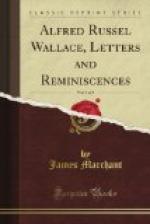directed to them. But then if, as in nature,
when you turn your gaze to one of these objects in
order to see it clearly, you cannot do so, this is
a defect. Again, I believe that we actually see
in a good photograph better than in nature, because
the best camera lenses are more perfectly adjusted
than our eyes, and give objects at varying distances
with better definition. Thus in a picture we
see at the same time near and distinct objects easily
and clearly, which in reality we cannot do. If
we could do so, everyone must acknowledge that our
vision would be so much the more perfect and our appreciation
of the beauties of nature more intense and complete;
and in so far as a good landscape painting gives us
this power it is better than nature itself; and I
think this may account for that excessive and entrancing
beauty of a good landscape or of a good panorama.
You will think these ideas horribly heterodox, but
if we all thought alike there would be nothing to
write about and nothing to learn. I quite agree
with you, however, as to artists using both eyes to
paint and to see their paintings, but I think you quite
mistake the theory of looking through the “catalogue”;
it is not because the picture can be seen better with
one eye, but because its effect can be better seen
when all lateral objects are hidden—the
catalogue does this. A double tube would be better,
but that cannot be extemporised so easily. Have
you ever tried a stereograph taken with the camera
only the distance apart of the eyes? That must
give
nature. When the angle is greater
the views in the stereoscope show us, not nature, but
a perfect reduced model of nature seen nearer the
eye.
It is curious that you should put Turner and the Pre-Raphaelites
as opposed and representing binocular
and monocular painting when Turner himself
praises up the Pre-Raphaelites and calls Holman Hunt
the greatest living painter!!...
Now for Mr. Darwin’s book. You quite misunderstand
Mr. D.’s statement in the preface and his sentiments.
I have, of course, been in correspondence with him
since I first sent him my little essay. His conduct
has been most liberal and disinterested. I think
anyone who reads the Linnean Society papers and his
book will see it. I do back him up in
his whole round of conclusions and look upon him as
the Newton of Natural History.
You begin by criticising the title. Now,
though I consider the title admirable, I believe it
is not Mr. Darwin’s but the Publisher’s,
as you are no doubt aware that publishers will
have a taking title, and authors must and do give
way to them. Mr. D. gave me a different title
before the book came out. Again, you misquote
and misunderstand Huxley, who is a complete convert.
Prof. Asa Gray and Dr. Hooker, the two first
botanists of Europe and America, are converts.
And Lyell, the first geologist living, who has all
his life written against such conclusions as Darwin
arrives at, is a convert and is about to declare or
already has declared his conversion—a noble
and almost unique example of a man yielding to conviction
on a subject which he has taught as a master all his
life, and confessing that he has all his life been
wrong.




